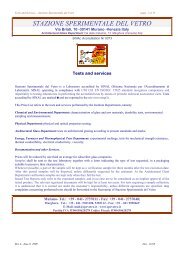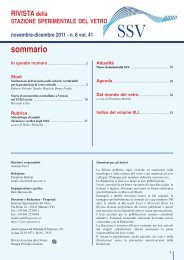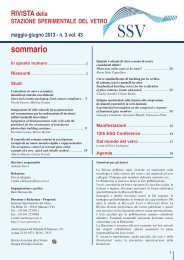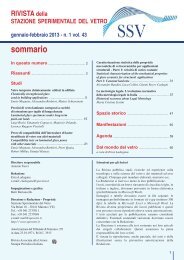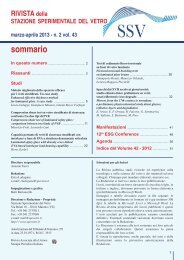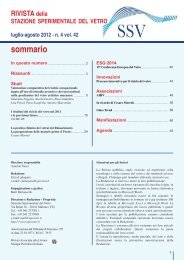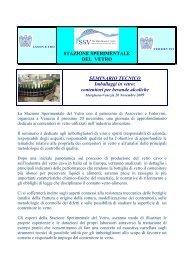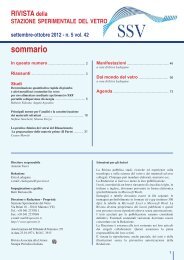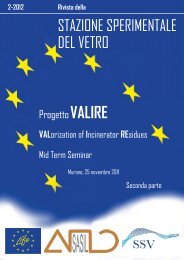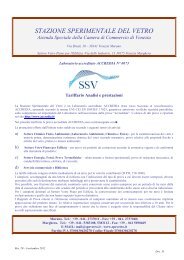RSSV 4 2013.indd - Stazione Sperimentale del Vetro
RSSV 4 2013.indd - Stazione Sperimentale del Vetro
RSSV 4 2013.indd - Stazione Sperimentale del Vetro
Create successful ePaper yourself
Turn your PDF publications into a flip-book with our unique Google optimized e-Paper software.
4-2013<br />
studies<br />
studi<br />
Rivista <strong>del</strong>la <strong>Stazione</strong> <strong>Sperimentale</strong> <strong>del</strong> <strong>Vetro</strong><br />
In addition to working problems, rigid warm-edge<br />
spacers present also some intrinsic differences compared<br />
to aluminum spacers. Warm-edge spacers<br />
have a different coefficient of linear thermal expansion<br />
from aluminum. Changing temperatures can<br />
result in a stronger stress on the butyl sealant, weakening<br />
the most important defense of the glazing unit<br />
from gas leakages and moisture penetration.<br />
Table 1 here below shows the coefficients of linear<br />
thermal expansion of warm-edge spacer components.<br />
Only steel has a lower coefficient than aluminum.<br />
Table 1. Coefficient of linear thermal expansion of<br />
warm-edge spacer components<br />
Spacers are made of composite materials. Their expansion<br />
will therefore depend on the interaction of<br />
those materials.<br />
“Flexible” spacers:<br />
- Homogeneity of application of butyl on foam back.<br />
- Extrusion temperatures and homogeneity of shape<br />
for the butyl types.<br />
- Mechanical behavior during pressing.<br />
- Joint closure.<br />
- Material adhesion to the second sealant.<br />
- High permeability of foams to the gas.<br />
2. UNI 1279-2/3 tests on different compositions of<br />
insulating glazing units<br />
The <strong>Stazione</strong> <strong>Sperimentale</strong> <strong>del</strong> <strong>Vetro</strong> launched a<br />
testing campaign to compare different materials -<br />
aluminum spacers and “rigid” warm-edge spacers.<br />
This campaign studied also the difference between<br />
glazing units made only of float glass and glazing<br />
units with low-emission glass which had undergone<br />
edge-coating removal. The following tests on samples<br />
manufactured in normal fabrication conditions<br />
were performed:<br />
- Dew point.<br />
- Initial gas concentration.<br />
- Final gas concentration.<br />
- Evaluation of the penetration index (I %).<br />
- Measure of gas leakage (Li %).<br />
The test outcomes led to the following findings:<br />
- Dew point: in some cases, condensation appears<br />
on samples before ageing, whereas on the same<br />
samples no condensation was reported after ageing.<br />
According to one of the hypotheses formulated, the<br />
desiccant agent for some types of spacers takes a<br />
long time to absorb the moisture inside the glazing<br />
unit, due to inappropriate holes “drilling” and subsequent<br />
poor exchange of air in the cavity.<br />
- Initial gas concentration: in general, the registered<br />
values fell within the limits provided for in the standards<br />
(+10%, - 5% with reference to the declared<br />
concentration).<br />
- Final gas concentration (after ageing): in some<br />
cases a quite significant decrease (up to 10%) in gas<br />
concentration was registered.<br />
- Initial moisture level in desiccants: it sometimes<br />
appeared high, proving that some types of spacers<br />
absorb moisture during storage.<br />
- Evaluation of the penetration index (I %) and Li<br />
measure: the comparisons between the data collected<br />
in ITT tests, those obtained repeating the tests<br />
performed the year before and the tests carried out<br />
with “rigid” warm-edge spacers of 45 manufacturers<br />
are reported here below.<br />
3. Penetration Index Values (I)<br />
Samples with rigid warm-edge spacers and L.E.<br />
have higher average I values and dispersion, which<br />
are often over the limits permitted by the standards<br />
(I ≤ 20), as shown in figure 1.<br />
In addition to the working problems mentioned<br />
above, one of the hypotheses is that this phenomenon<br />
is due to different stresses on the permeability<br />
profile by expansions of W.E. spacers subject<br />
to temperature range imposed by ageing cycles<br />
(+58°C; -18°C ). However, this hypothesis cannot<br />
explain such a widespread and sometime serious<br />
problem.<br />
6



